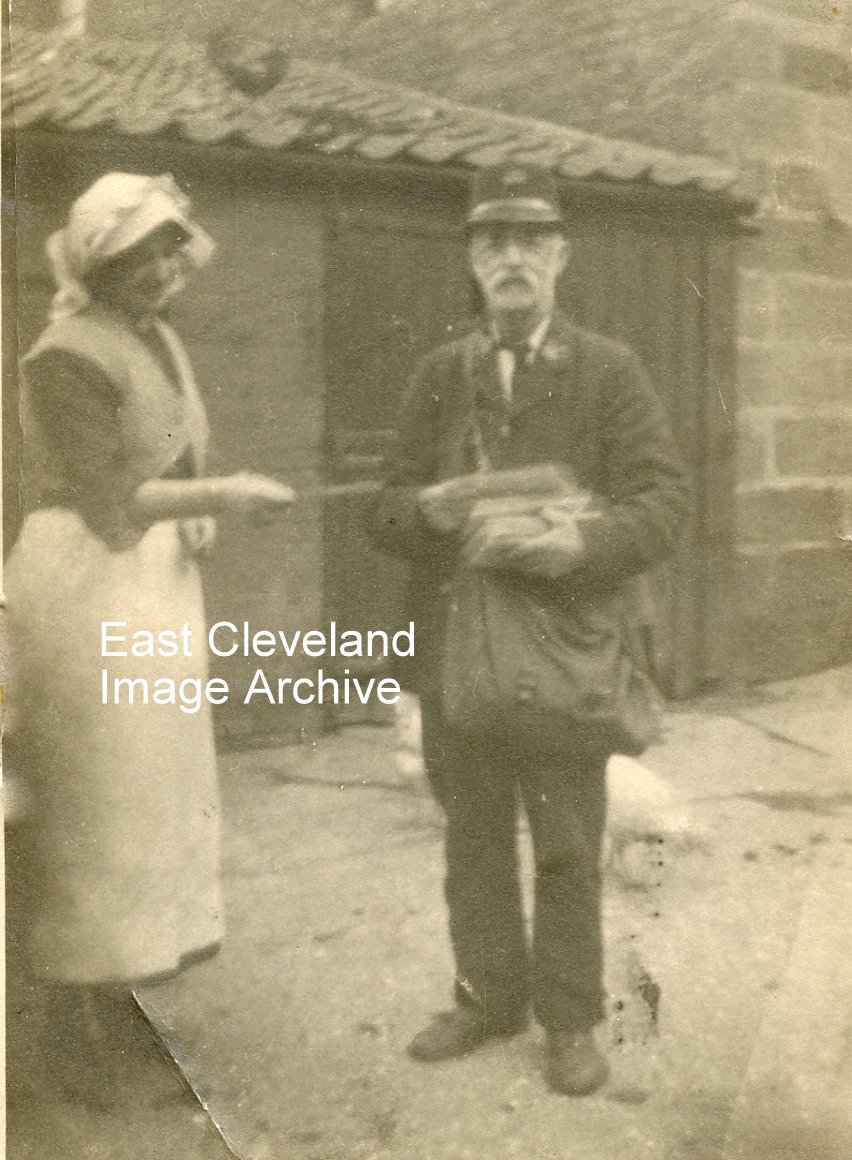
After featuring the postman handing mail to Mary Bennison in this photograph, taken in 1922; we were told by Pauline Morrell: “This is Thomas Hansell my great grandad.”
Image courtesy of Mr. Ray Conn and thanks to Pauline Morrell for the update.
|
|
||
|
After featuring the postman handing mail to Mary Bennison in this photograph, taken in 1922; we were told by Pauline Morrell: “This is Thomas Hansell my great grandad.” Image courtesy of Mr. Ray Conn and thanks to Pauline Morrell for the update.
Mr. Bennison, John Dowey and Mr. Manning Robert Russell sitting on the bench outside the Institute at Boulby ’Tin City’. John Russell tells us: ”The gentleman sitting at the right hand end of the bench is my great grandfather Manning Robert Russell (1852 – 1936). He originated from Brigstock in Northamptonshire and after a few years working in the Durham collieries worked as a under-manager at a Boulby Ironstone Mine from 1908 – 1927. Any further information or memories would be very welcome.” Image courtesy of Mr. Ray Conn and many thanks to John Russell for the update.
Not alive with the sound of music, but more alive with the sound of mining. This postcard view by Lilywhite Ltd, shows the Eston Hills long before the present day ‘Parkway – A174’ roadway was even thought about!
Ray Conn’s grandparents; Katie and Stephen Wilkinson Easton, standing in front of one of the cottages at Boulby in 1918. Ray has told us that Stephen Wilkinson Easton carved his initials; S.W.E. on a stone at the quarry and it is still there. Vivienne Story (nee Easton) tells us: ” Kate and Stephen I believe are my Great Grand Parents.” Image and information courtesy of Mr. Ray Conn and many thanks to Vivienne Story for the update.
Ray Conn’s parents; Margaret and Norman Bennison Conn, at Boulby Cottages. Image courtesy of Mr. Ray Conn.
So you think that sand yachts are modern! This beautifully quaint contraption took V.I.Ps, Military servicemen and Lighthouse crew out to the Lighthouse and Gun installations at the end of South Gare. Robin Jones in ”Britain’s Bizarre Railways” has details of the South Gare Sail Trolley from the 1895 period. As we discover more details regarding the sail train which come to light we will update this comment. The sail trains apparently operated in other situations. We will be uploading the additional images and information shortly.
This might be a bit tricky to see – but it’s a panoramic scan photograph, taken at Guisborough Grammar School in June 1940 – you never know, you might spot someone you know! Geoff Bailey comments: “Thanks to Norman Patton, Owen Rooks, Ray Harrison, Paul Taylor, John Wright, John McLean, Rodney Wood, Geoff Bailey, David Hore and Lee Easom for names to date. However this is not me. I failed the 11+ and went to Guisborough County Modern School not the Grammar School. That is my brother Terry (now deceased) however. Geoff Bailey” Image courtesy of Norman Patton and thanks to Norman Patton, Owen Rooks, Ray Harrison, Paul Taylor, John Wright, John McLean, Rodney Wood, Geoff Bailey, David Hore and Lee Easom for names to date.
The lighthouse at the termination of the South Gare was supported by a sail train; this image is believed to be from the official opening to the Lighthouse at the South Gare. A similar conveyance operated to the Lighthouse at Spurn Point; instead of an Engine Driver, we have a sailor as Helmsman, we wonder what A.S.L.E.F (Rail Union) would make of it today? Image courtesy of Mike Holliday.
South Skelton Pit (or Van’s Pit as it was locally known – after the owner – Thomas Vaughan) is sited between Boosbeck and Margrove Park. A nicely compact pit, this image shows the winding shaft and engine house built over and onto the heapstead. The two strange dovecot-type structures in the centre foreground are horse-gins used for working the winding shaft when engineering work was required below. Not much remains today, the mine manager’s house, two overmen’s houses, the stables and the engine house are about all I can bring to mind. The shale heap at Margrove Ponds Nature Reserve was waste from the mine and the pond itself was caused by subsidence from the mine. Image courtesy of the Pem Holliday Collection.
Grandmother Katie Easton holding a very young Ray Conn at 6 Boulby Cottages. The cottages, known locally as Tin City, were listed in the 1911 census as Iron Cottages. They were built by Skinningrove Iron Company to house the miners working at the Boulby Ironstone Mine. The first ones were occupied by the end of 1906. They were semi-detached bungalows built from corrugated iron sheeting on timber frames, standing on concrete foundations. The Boulby Mine finally closed in 1934 and in October 1936 The Ministry of Health issued a demolition order as part of a ”slum clearance scheme”; much to the residents displeasure. Over the next few years the tenants moved out and the cottages were demolished. Ray Conn has told us that tin sheets and timber went to Wards Farm at Roxby and were used to build a large shed. Anthony Mugfordf tells us: “I discovered a relative – Thomas Mugford – who was an ironstone miner, who lived with his family at number 8. There was Thomas, wife Gertrude, adult son Thomas and children Gertrud, Dora, Florence, Lavinia and Hilda.” Image courtesy of Mr. Ray Conn, additional information courtesy of cuttings from Northern Echo 24th October 1937 and materials courtesy of Eric Jackson; also to Anthony Mugford for the update. |
||
Recent Comments